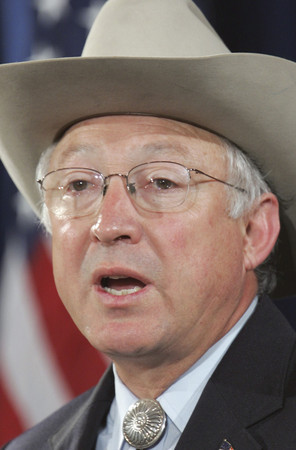Nevada on renewable fast track

Two planned solar stations in Nevada could be among the first renewable-energy plants to result from a new federal push toward green fuels.
NextLight Renewable Power, a California developer of alternative energy, has applied for permits to build two photovoltaic plants on public lands near Primm. Under a plan federal officials announced Monday in Las Vegas, the projects could be under way sometime by 2010.
Interior Secretary Ken Salazar cited NextLight’s proposals as the first solar plants poised for fast-tracked construction permits under an initiative that will reserve 670,000 acres of Western public lands for the development of solar power.
As many as 13 plants could be under construction by the end of 2010 in Nevada, California, Arizona, Utah, Colorado and New Mexico, Salazar said.
The Interior Department would break the 670,000 acres of Bureau of Land Management property into 24 Solar Energy Study Areas and would expedite solar projects on the parcels. The federal government has already spent $22 million establishing fast-track environmental-impact studies for projects on the sites, which aren’t near national parks or military stations, Salazar said.
"It is time for a new energy frontier, a comprehensive energy plan that encompasses renewable energy," Salazar said. "This is part of a directive from President Barack Obama to do everything we can to put a bulls-eye on the development of solar energy on public lands across America."
Maps of the study zones weren’t scheduled to be available until today in the Federal Register.
The NextLight projects would provide 407 megawatts of power, compared with the 350 megawatts a midsized, coal-fired power plant generates.
James Woodruff, vice president of regulatory and government affairs for NextLight, didn’t provide a completion date for the arrays, but he said the company is working to begin construction and bring the plants online as soon as possible.
"The announcement by Secretary Salazar today represents a welcome commitment by the Bureau of Land Management to moving these projects forward expeditiously," Woodruff said.
Officials of local power utility NV Energy welcomed Monday’s announcement, saying the measure could help their company meet the state’s renewable-energy mandates. Nevada law requires 25 percent of the state’s power to come from renewable resources by 2025, with 6 percent coming from solar energy by 2016.
Michael Yackira, chief executive officer of NV Energy, said the utility and its plant developers have long hoped for a fast-track permitting process. Out-of-state power sellers can charge more for their electricity if they know a utility faces bureaucratic hurdles developing capacity to meet mandates, so speeding up plant approvals would yield lower prices on solar power and make it easier to match the state’s renewable yardstick, Yackira said.
"This process will facilitate job development in the state, improve our ability to make the portfolio standard and keep the cost of renewable energy down," Yackira said. "Perhaps we can get to a point where we can actually export renewable energy to the benefit of our customers."
Senate Majority Leader Harry Reid, D-Nev., attended the Monday announcement with Salazar at the University of Nevada, Las Vegas. Reid said the government has set aside 40 million acres of Bureau of Land Management property for the development of oil and natural gas resources, and it’s time to dedicate public lands to encouraging renewable energy. He called Nevada the "Saudi Arabia" of solar and geothermal energy.
"We hear a lot about doing something for the environment," Reid said. "That’s what this is all about. Today, we will use 21 million barrels of oil in the United States. We want to back that off. We are not a secure nation as long as we’re importing oil."
Power developers and operators have submitted 158 applications to build solar projects on public land, including 35 proposals for plants within the 24 Solar Energy Study Areas. If all 158 plants were built, they could produce 97,000 megawatts of electricity, or enough juice to power 29 million homes.
Salazar said the initiative will create 50,000 jobs. Interior spokesmen weren’t able to say late Monday how many of those jobs would be temporary construction positions and how many would be permanent posts operating completed projects.
"I hope, when people look back in the year 2020 to this announcement in the year 2009, they will see this as a true milestone in moving the United States of America forward to a renewable-energy future that at its heart has national security and jobs, jobs, jobs for the people of America," Salazar said.
The National Republican Senatorial Committee released a statement calling Monday’s event a "photo op" designed to "help prop up (Reid’s) sagging approval numbers," and saying that Reid’s liberal energy agenda would hurt his constituents.
"If energy is topic one for Harry Reid in Nevada today, he should address the number one question surrounding the cap-and-tax legislation he’s pushing in the Senate — why, at a time when Nevada’s unemployment is over 11 percent, he’s trying to pass a bill that even liberal and nonpartisan experts predict will lead to fewer jobs and higher taxes," said committee spokesman Brian Walsh.
Contact reporter Jennifer Robison at jrobison@reviewjournal.com or 702-380-4512.
More about NextLight Renewable PowerBY THE NUMBERS
50,000: Jobs the plan could create
670,000: Acres of public land set aside for solar projects
158: Applications submitted for solar plants on BLM land
35: Applications submitted within solar study zones
13: Plants expected to be under construction in zones by the end of 2010
$22 million: Amount federal government has spent to expedite solar permits in zones












